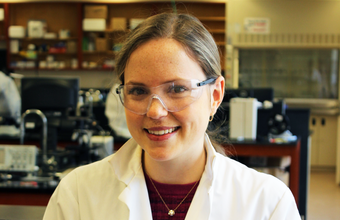
Some researchers make amazing discoveries, and then wait years to see their research have an impact outside of the lab.
For Hannah Dies, her research is already making waves around the world.
Hannah’s PhD research in chemical engineering focuses on sensing techniques and plasmonics – techniques she uses which allow her to detect small chemicals in a fluid. Her goal is to create small, portable, cost-effective sensors which could be used in industries like law enforcement and health care. For instance, using one of Hannah’s sensors in the future could allow a police officer to detect whether a motorist is impaired by drugs by examining their saliva.
“My undergraduate program was an interdisciplinary and very research focused program which concentrated on all areas of science with a focus on physics,” she says. “I thought I would have to pick medicine or physics when I pursued further studies. Realizing that those two weren't necessarily contradictory and that they could complement each other was an exciting moment.”
Hannah described being accepted to the MD/PhD program at Queen’s in 2014 as a ‘dream come true’. While she could have stayed in Hamilton, she was advised to branch out and try somewhere else – and she saw transitioning to chemical engineering as a challenge she wanted to take on.
“I didn’t have a masters and I was starting a PhD in a new field, so I knew I was going to need more support from my supervisor,” she says. “I was glad to know it was going to be a very supportive environment while also offering a top-notch research environment.”
Hannah is currently five years into her PhD and is preparing to defend in spring 2019. Her research, in collaboration with her supervisors Dr. Aristides Docoslis and Dr. Carlos Escobedo and fellow PhD student Joshua Raveendran, forms the basis of the startup Spectra Plasmonics – a start-up comprised of previous Queen’s students who are looking to commercialize the sensor technology.
“Two years ago, we pitched our research to the Office of Partnerships and Innovation seeking a student team to bring the research to market,” she says. “The best success you can have with research is to make it known and to make it used, and Engineering is all about application. We went forward with the pitch, and they have proven to be a constant source of motivation for me ever since. It is really neat to see someone be excited about the project that I had been working on for two years.”
Last year, the Spectra Plasmonics team won a significant award at a start-up competition in Singapore and they recently won a start-up award in Japan. Behind the scenes, Hannah continues to refine and improve upon the design.
“My research takes sensing technologies that would normally only exist in a lab and makes them small and potentially portable, enabling their use in remote sensing environments and point-of-care applications,” she says. “These sensing structures are on a micro scale – one millionth of a metre. I build the sensors using electric fields to manipulate nanoparticles and create everything from basic structures like nanowires into broader structures that can capture more light interactions – and it is those light interactions which help us enhance our detection.”
When she’s not peering through a microscope at tiny sensors, Hannah can be found in the great outdoors enjoying the short distance from campus to the waterfront or going for a jog. Hannah also recently participated in a School of Medicine talent show where she sang and played piano – a welcome break from the lab.
“It’s important to remember you're not just here as a researcher and you're not just here to produce data,” she says. “It's so important to engage in other things that are offered by the university during your studies. Queen’s has many offerings, but they don't hit you in the face if you don't go looking for them. It's a great environment to learn to study and to live.”
To learn more about the Queen’s MD/PhD program, visit the School of Medicine’s website.